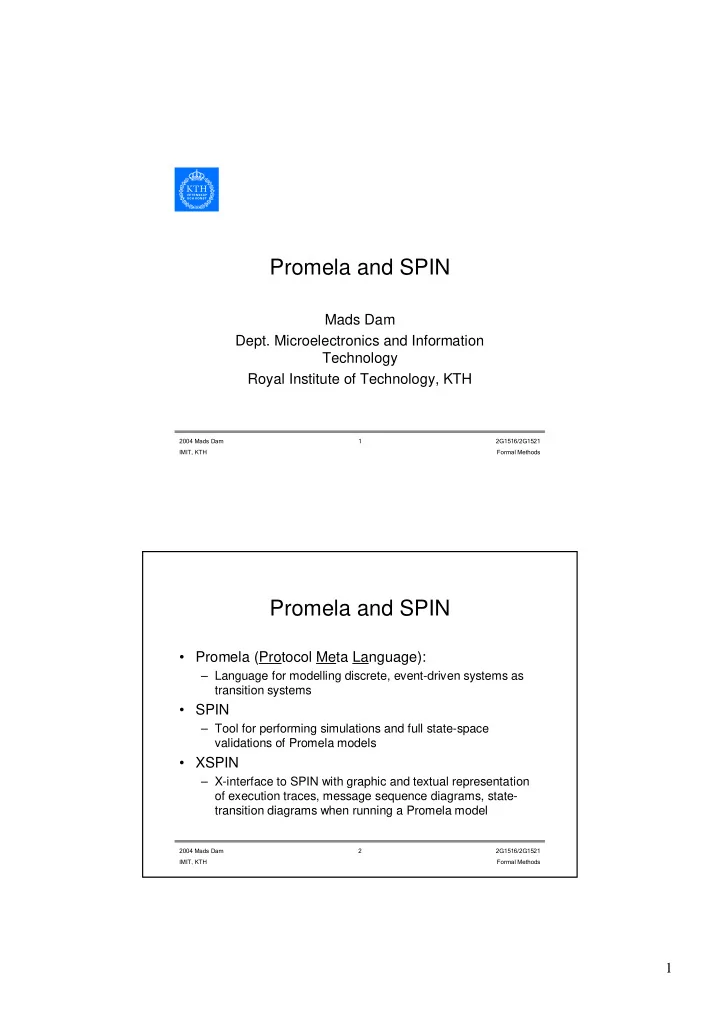

Promela and SPIN Mads Dam Dept. Microelectronics and Information Technology Royal Institute of Technology, KTH ������������� � ������������� ��������� �������������� Promela and SPIN • Promela (Protocol Meta Language): – Language for modelling discrete, event-driven systems as transition systems • SPIN – Tool for performing simulations and full state-space validations of Promela models • XSPIN – X-interface to SPIN with graphic and textual representation of execution traces, message sequence diagrams, state- transition diagrams when running a Promela model ������������� � ������������� ��������� �������������� 1
Promela and SPIN Promela and SPIN/XSPIN are – Developed by Gerard Holzmann at Bell Labs – Freeware for non-commercial use – State-of-art model checker (another is SMV) – Used by more than 2000 users See course binder and SPIN home page for more information ������������� � ������������� ��������� �������������� Promela Models • Describe (possibly very large but) finite transition system • Essentially: – No unbounded data – No recursive processes – No unbounded process creation • SPIN traverses the finite transition system • States constructed as they are visited (on-the-fly) – CWB equivalence checker constructs state space in advance • Temporal logic: Specifications represented as transition systems • This lecture: Getting started with Promela ������������� � ������������� ��������� �������������� 2
SPIN vs CCS SPIN: CCS: • Dressed up automata • Dressed up automata • Verification by traversing • Verification by traversing states states • ”Realistic” program model • Elegance of theory • Linear time • Branching time • Properties as automata • Properties as logic • On-the-fly state space • State space constructed ”in exploration advance” • Sharable store • No store • Buffered comms • Primitive, synchronous comms ������������� � ������������� ��������� �������������� Alternating Bit Protocol �������������������� ���������*����������������������� �! ������������������������������������ � ������������������������������������ �������"�#� �� ������������������������������� �! $$���(�������"�#!�&' � � �%�������"�#! ��������"�#�����"�#� $$������ ��&' �� � �%�������"�#! $$�� �%��������"�#!�&' �� ��(�������"�#!� � �� $$����"�#��������"�#�&' ���� ����"�#���)�& ���"�# � $$��#���&'����� � ������������������������!� �� � ��*�����������������������! �� � � ������������� � ������������� ��������� �������������� 3
Promela ���������������+++ Promela model: • Process types ��������������������������������� �! � • Channel declarations +++ � • Variable declarations • Main program ���������*������������������������ �! � +++ � ���� � +++ � ������������� � ������������� ��������� �������������� Processes A process – executes concurrently with all other processes, independent of speed and behaviour – communicates with other �������������������������������� �! processes using channels � – may access shared +++ variables � – follows the description of a process type There may be several processes of the same type Each process has own local state ������������� � ������������� ��������� �������������� 4
A Process Type Process name A process type consists of – a name ������������������������������� �! � – a list of formal parameters Formal ��������"�#�����"�#� – local variable declarations �� parameters – body $$�� �%��������"�#!�&' ��(�������"�#!� �� Local variable $$����"�#��������"�#�&' ����"�#�%�� declarations ���"�# $$��#���&'����� �� �� Body � ������������� � ������������� ��������� �������������� Process Creation • Processes created by � � ����������������,! statement �����+++����� • Value of run statement is a ���� process identifier � +++�� � �����!�� • Processes can be created at ���-���� �����!�� any point of execution +++ • Processes start executing � after execution of run Number of processes created (optional) statement • Processes can also be �������.�����������/���������! created by adding ������ in ����+++����� Obs: No parameter front of process type when using active declaration ������������� �� ������������� ��������� �������������� 5
Data Types and Variables Integers • Five different types of �����#����� ���) [0..1] integers as basic types ���#������ [0..1] • Records and arrays for ������� ���� [0..255] [-2 15 ..2 15 -1] compound data ��������#���� [-2 31 ..2 31 -1] ��������� • Type conflicts detected at Records ”runtime” ��������0��#��� • Default initial value 0 ������������1�� �������� ��� Arrays ��������2������ ������#����-� �� ������������� �� ������������� ��������� �������������� Tests and Assignment • Assignment with single equals sign: ����� • Testing for equality: ������ • Inequality: ��%��� • Comparisons: ��'�������3��� • Logical conjunction: ����44���� • Disjunction: ����55���� • Negation: %��� ������������� �� ������������� ��������� �������������� 6
Channels �������������������������� Channels model transfer of data between processes Type of fields Name in each slot Size of buffer Each channel has typed buffer of finite length ������������������� Special type mtype used for Has value 1 enumerating message types ��������������������������������� Enumerated from 1 upwards ������������� �� ������������� ��������� �������������� Channels, cont’d • Channel: Fifo buffer with Receive statement: number of slots, each with ���6(�������"�# same number and types of Equivalently: fields ���6(�������"�#! Executable only if buffer nonempty • Several processes can share same channel Send statement: � ��6%��������"�# • A channel is usually, but not Equivalently: always, used unidirectionally � ��6%��������"�#! between two processes Default: Executable when buffer has at least 1 free slot ������������� �� ������������� ��������� �������������� 7
Recommend
More recommend